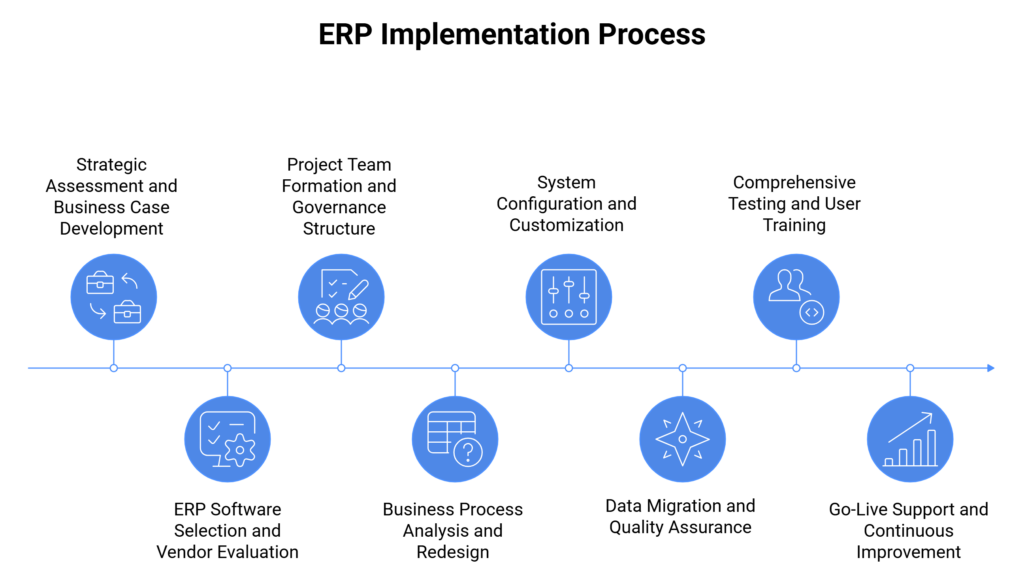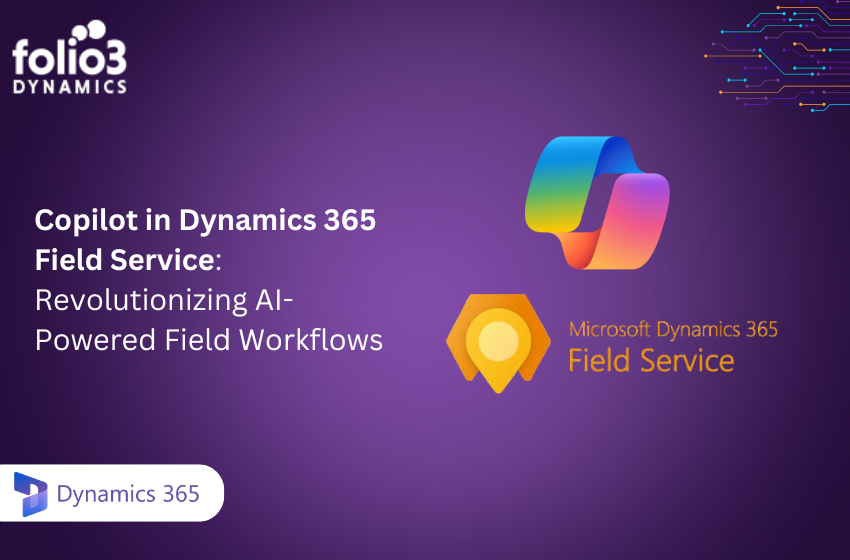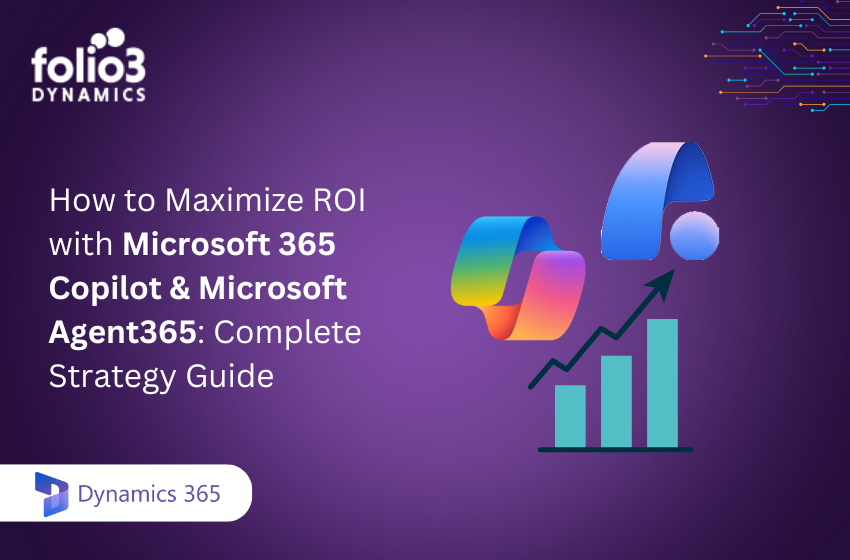Why do some companies spend millions on ERP projects only to watch them fail, while others achieve remarkable transformation? The difference isn’t technology; success lies in the execution strategy.
As per the research conducted by Gartner, 55% to 75% of ERP implementations don’t meet expectations. Yet 67% of organizations describe their implementations as successful. This gap reflects fundamental differences in approach, not system capabilities.
This blog walks you through eight proven steps that separate successful implementations from expensive failures. Each step builds on real-world experience from hundreds of enterprise deployments across industries.
Understanding ERP System Implementation
Most organizations struggle with disconnected systems that create operational blind spots. Your sales team can’t see inventory levels. Finance works with outdated data from multiple spreadsheets. Manufacturing operates without real-time demand visibility. These silos cost money, slow decision-making, and frustrate customers.
ERP system implementation solves these fundamental problems by creating a single source of truth across your organization. Instead of juggling separate applications for accounting, inventory, HR, and operations, you get unified visibility that drives smarter decisions.
When you implement ERP systems effectively, departments finally communicate seamlessly. Sales teams access real-time inventory data before promising delivery dates. Finance teams close books in days instead of weeks. Manufacturing adjusts production based on live demand signals.
The implementation of ERP requires migrating from legacy systems, redesigning workflows, and establishing governance protocols. Success depends on treating this as organizational transformation rather than technology deployment.
Why Your Implementation Strategy Matters
Enterprise resource planning has become critical infrastructure. North American ERP market reached $20 billion in 2024, projecting growth to $32 billion by 2029 as companies modernize operations.
Organizations implementing ERP effectively see measurable returns. However, achieving benefits requires comprehensive planning that aligns technology with business objectives.
Your implementation approach determines success. Failed projects damage team confidence, erode stakeholder trust, and delay digital transformation initiatives. You cannot afford implementation mistakes. Hence, here is a step-by-step plan which will help you in implementing ERP successfully.
What is the Successful ERP Implementation process?
Like any major initiative, an ERP implementation requires a structured and step-by-step approach. While every organization has its own nuances, the journey typically follows eight core phases that form the backbone of the ERP life cycle. Skipping or rushing through any of them can put the entire project at risk.
The timeline for completing these stages isn’t fixed, it varies depending on the company’s priorities, resources, and pace of execution. On average, most businesses move from initial planning to a fully functional ERP system within six to twelve months.
In the sections below, we’ll break down each phase of the ERP implementation life cycle. To ensure a solid outcome, it’s important that one stage is thoroughly finalized before moving on to the next, creating a strong foundation for long-term success.
Step 1: Strategic Assessment and Business Case Development
Everything begins with understanding why you need ERP implementation. Your business case must quantify current problems with specific numbers.
First, you need to document system limitations that impact daily operations. Also, calculate time consumed by manual processes, along with compliance risks from outdated technology. Interview department heads who manage current system constraints.
You need to establish measurable success criteria for ERP implementation. For example, reduce month-end close time from two weeks to three days, or cut inventory costs by 15%. These targets guide implementation decisions and measure progress.
Assessment Requirements:
- Current technology gaps and process inefficiencies
- Quantified operational costs and productivity limitations
- Specific business outcomes your ERP system must deliver
- Success measurement criteria and timeline expectations
- Organizational readiness for technological change
Skip thorough assessment, and you’ll encounter scope creep, budget overruns, and stakeholder conflicts later.
Step 2: ERP Software Selection and Vendor Evaluation
Your software choice determines implementation complexity, timeline, and operational value. Modern enterprises increasingly choose cloud solutions. 64% prefer SaaS ERP, such as Microsoft Dynamics 365, because it eliminates infrastructure complexity, and reduces cost while accelerating deployment.
Cloud-based ERP implementation typically reduces project duration by 25-40% compared to on-premises alternatives. These systems provide automatic updates, built-in scalability, and enhanced disaster recovery capabilities.
Evaluate vendors based on industry expertise and implementation track records. A vendor experienced in your sector brings insights that generic providers cannot match.
Selection Criteria:
- Proven success with similar organizations
- Implementation methodology matching your risk tolerance
- Support quality during critical deployment periods
- Integration capabilities with existing applications
- Product roadmap alignment with business strategy
Choose implementation partners who’ll guide you through complex organizational change, not just software vendors.
Step 3: Project Team Formation and Governance Structure
A successful ERP implementation depends on the right mix of expertise. Executive sponsors secure resources and organizational backing, while project managers coordinate activities and keep stakeholders aligned. Business process owners ensure configurations reflect real workflows, and technical architects design systems that meet current and future needs. To support adoption, change management specialists guide employees through transitions. Together, this balanced team drives both technical success and organizational buy-in.
Step 4: Business Process Analysis and Redesign
To implement an ERP system effectively requires examining how your organization operates versus how it should operate. Most companies discover improvement opportunities during analysis.
Map current workflows accurately. Document how work gets done, including workarounds and inefficiencies. Many organizations replicate existing processes in new systems instead of using implementation for operational improvement.
Also, identify bottlenecks that ERP automation can eliminate. Design workflows that leverage system capabilities and validate changes with stakeholders who understand operational requirements.
Process Redesign Elements:
- Current state documentation with pain point identification
- Future state design using ERP automation capabilities
- Stakeholder validation of workflow changes
- Training material development for new processes
- Change management planning for user adoption
Your process redesign efforts directly impact business value from ERP investment.
Step 5: System Configuration and Customization
The ERP implementation process requires balancing standard functionality with specific business requirements. Excessive customization increases complexity and costs. Insufficient configuration may not address operational needs.
Hence, focus customizations on processes that differentiate your business and use standard functionality wherever possible. Document configuration decisions and establish change control procedures for future modifications.
Technical teams should collaborate with business stakeholders to ensure configuration supports optimized workflows while maintaining upgrade compatibility.
Step 6: Data Migration and Quality Assurance
Implementing ERP systems requires migrating information from multiple legacy platforms while ensuring accuracy. Poor data migration causes implementation failures.
Audit existing data sources and cleanse information before migration. Establish validation protocols that verify data integrity and focus data migration on operationally relevant information rather than transferring all historical data.
Migration Strategy:
- Data source auditing and requirement definition
- Information cleansing and standardization procedures
- Validation rules and quality checkpoint establishment
- Testing protocols with rollback procedures
- Governance policies for ongoing data maintenance
Step 7: Comprehensive Testing and User Training
Your ERP implementation timeline must include extensive testing that validates functionality, data integrity, and workflows. Testing should progress from individual components to complete business processes.
Concurrent with testing, comprehensive user training ensures adoption. Training programs should focus on role-specific functionality while helping users understand their contribution to organizational objectives. Inadequate testing and training result in user resistance and decreased productivity after deployment.
Testing Framework:
- Unit testing of modules and features
- Integration testing of data flows
- User acceptance testing with business scenarios
- Performance validation under expected volumes
- Security verification of access controls
Step 8: Go-Live Support and Continuous Improvement
ERP implementation phases culminate in deployment, but success extends beyond go-live activities. You must provide intensive support during initial operation while establishing continuous improvement processes.
Deploy dedicated support teams for initial weeks. Establish escalation procedures for critical issues. Monitor system performance and user adoption metrics. Collect feedback systematically and prioritize enhancements based on business impact.
Treat ERP deployment as the beginning of ongoing improvement rather than project completion.
ERP Implementation Timeline and Planning Considerations
Your ERP implementation timeline depends on organizational complexity, system scope, and implementation approach. The ERP implementation process typically requires 6-18 months from initiation to deployment for enterprise organizations.
Small to medium enterprises often complete implementations within 3-9 months using standard ERP implementation methodology. Large enterprises with complex requirements may need 12-24 months. Cloud implementations generally proceed faster than on-premises deployments.
An effective ERP implementation plan accounts for data migration complexity, user training requirements, and change management needs. Your ERP implementation guide should include realistic timelines rather than optimizing for speed alone.
Navigating Common Implementation Challenges
Even well-planned implementations face predictable obstacles that can derail timelines and budgets. Understanding these challenges beforehand allows you to build mitigation strategies into your project plan.
- Budget Overruns: ERP projects frequently exceed initial budgets due to hidden complexities. Data migration alone represents 10-15% of total project costs. Consultant fees at $150-175 per hour accumulate quickly when internal resources become stretched. Hence, build 20-30% contingency reserves into your budget for unforeseen complications.
- Data Migration Difficulties: Your organizational data likely spans accounting systems, spreadsheets, and paper records across multiple locations. Data quality issues compound migration complexity, duplicate customer records, inconsistent formats, and obsolete information require extensive cleanup before migration. Therefore, assign data responsibilities to specific departments based on expertise.
- User Resistance: Employees resist workflow changes that disrupt familiar routines perfected over years. Address resistance through early change management communication that emphasizes individual benefits. Involve power users in configuration decisions to create ownership rather than imposition.
- Technical Integration Complexity: Legacy systems may lack modern API connectivity that simplifies ERP integration. Third-party applications often require custom development to work with new platforms. Document existing system integrations during planning and allocate appropriate technical resources for complex connectivity requirements.
Your ERP Success, Powered by Microsoft Dynamics Experts!
Successful ERP implementation transcends technical deployment. It requires strategic vision, thorough planning, and sustained commitment to organizational transformation. This 8-step framework gives you proven methodology for achieving success while avoiding expensive pitfalls.
Ready to transform your organization with successful ERP implementation? Folio3 Dynamics specializes in enterprise implementations that deliver measurable business value. Our proven methodology and industry expertise help you navigate complex implementations while minimizing risk and accelerating results. Contact Folio3 Dynamics today to discuss your requirements and discover how our strategic approach drives business transformation success.
FAQs
How long does it take to implement an ERP system?
An ERP implementation typically takes 6 to 18 months, depending on company size, system complexity, and deployment model. Cloud-based ERP solutions are often faster, completing within 3–9 months, while large on-premises projects may extend to 12–24 months.
Why do most ERP implementations fail?
Most ERP failures stem from poor planning, weak change management, unclear objectives, and data migration issues. Organizations that rush implementation or lack executive sponsorship often face cost overruns, user resistance, and missed business outcomes. A structured strategy greatly reduces failure risk.
How much does ERP implementation usually cost?
ERP implementation costs vary from $150,000 to several million dollars, depending on company size, customization needs, and vendor choice. Cloud ERP lowers upfront expenses with subscription pricing, while on-premises solutions often require higher initial investments in hardware, licenses, and IT resources.
What are the best practices for a successful ERP implementation?
Key best practices include clear business objectives, strong executive sponsorship, thorough process analysis, clean data migration, comprehensive user training, and phased testing. Success depends on aligning technology with business goals while ensuring employees adopt new processes seamlessly.
Is ERP suitable for small and medium-sized businesses?
Yes, ERP is highly beneficial for SMBs. Modern cloud-based ERP solutions are affordable, scalable, and easy to deploy. They help streamline accounting, inventory, HR, and operations, enabling small businesses to improve efficiency and compete with larger enterprises.
What should a company do after ERP go-live?
After ERP go-live, companies should provide ongoing user support, monitor performance, track adoption metrics, and gather feedback. Continuous process optimization and system updates ensure the ERP delivers long-term value rather than being treated as a one-time project.



